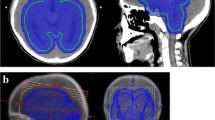Abstract
Because of possible long-term toxicity, cranial radiotherapy (RT) was withheld as part of standard treatment for brain metastasis (BM) from non-seminomatous germ cell tumours (NSGCT). This study evaluates this change in management in our institute. Twenty-two consecutive patients with BM from NSGCT were analysed. Ten patients presented with BM at initial diagnosis (group 1), two patients developed BM at extra-cranial complete remission (CR) (group 2), and ten patients during treatment of the primary tumour without achieving CR (group 3). All patients received cisplatin-based induction chemotherapy. In group 1, three patients with a single metastasis and three patients with multiple BM underwent craniotomy. Five patients received chemotherapy and whole brain RT (WBRT), and five patients received chemotherapy without WBRT. In group 2, both patients underwent craniotomy for a relapse with multiple BM. One patient received additional high-dose (HD) chemotherapy with WBRT, and the other HD chemotherapy without WBRT. In group 3, one patient underwent craniotomy, seven patients received WBRT, and four patients additional HD chemotherapy. In group 1, five of ten patients (50%) achieved CR (follow-up 49–245 months), in four of those five without WBRT. In group 2, both patients achieved CR (follow-up 146 and 211 months). In group 3, one of ten patients (10%) achieved CR after HD chemotherapy and WBRT (follow-up 107 months). It is concluded that cure in patients with BM from NSGCT can be achieved with standard induction chemotherapy without WBRT.
Similar content being viewed by others
References
Giwercman A, Carlsen E, Keiding N, Skakkebaek NE (1993) Evidence for increasing incidence of abnormalities of the human testis: a review. Environ Health Perspect 101(2):65–71. doi:10.2307/3431378
Swerdlow AJ, Dos Santos Silva I, Reid A et al (1998) Trends in cancer incidence and mortality in Scotland: description and possible explanations. Br J Cancer 77(Suppl 3):1–54
Schmoll HJ, Souchon R, Krege S et al (2004) European consensus on diagnosis and treatment of germ cell cancer: a report of the European Germ Cell Cancer Consensus Group (EGCCCG). Ann Oncol 15:1377–1399. doi:10.1093/annonc/mdh301
Bokemeyer C, Nowak P, Haupt A et al (1997) Treatment of brain metastases in patients with testicular cancer. J Clin Oncol 15:1449–1454
Fossa SD, Bokemeyer C, Gerl A et al (1999) Treatment outcome of patients with brain metastases from malignant germ cell tumors. Cancer 85:988–997. doi :10.1002/(SICI)1097-0142(19990215)85:4<988::AID-CNCR29>3.0.CO;2-R
Kollmannsberger C, Nichols C, Bamberg M et al (2000) First-line high-dose chemotherapy ± radiation in patients with metastatic germ-cell cancer and brain metastases. Ann Oncol 11:553–559. doi:10.1023/A:1008388328809
Hartmann JT, Bamberg M, Albers P et al (2003) Multidisciplinary treatment and prognosis of patients with central nervous metastases (CNS) from testicular germ cell tumor (GCT) origin. Proc Am Soc Clin Oncol 22:400
Rustin GJ, Newlands ES, Bagshawe KD et al (1986) Successful management of metastatic and primary germ cell tumors in the brain. Cancer 57:2108–2113. doi :10.1002/1097-0142(19860601)57:11<2108::AID-CNCR2820571103>3.0.CO;2-Z
Rustin GJ, Newlands ES, Begent RH et al (1989) Weekly alternating etoposide, methotrexate, and actinomycin/vincristine and cyclophosphamide chemotherapy for the treatment of CNS metastases of choriocarcinoma. J Clin Oncol 7:900–903
Workman P (1986) The pharmacology of brain tumour chemotherapy. In: Bleehen NM (ed) Tumours of the brain. Springer, Berlin, pp 183–200
Norris LK, Grossman SA, Olivi A (1997) Neoplastic meningitis following surgical resection of isolated cerebellar metastasis: a potentially preventable complication. J Neurooncol 32:215–223. doi:10.1023/A:1005723801479
Azar JM, Schneider BP, Einhorn LH (2007) Is the blood-brain barrier relevant in metastatic germ cell tumor? Int J Radiat Oncol Biol Phys 69:163–166. doi:10.1016/j.ijrobp. 2007.02.042
Hasegawa H, Ushio Y, Hayakawa T et al (1983) Changes of the blood-brain barrier in experimental metastatic brain tumors. J Neurosurg 59:304–310
Spears WT, Morphis JG, Lester SG et al (1991) Brain metastases and testicular tumors: long-term survival. Int J Radiat Oncol Biol Phys 22:17–22
Author information
Authors and Affiliations
Corresponding author
Rights and permissions
About this article
Cite this article
Gremmer, R., Schröder, M.L.J.F., ten Huinink, W.W.B. et al. Successful management of brain metastasis from malignant germ cell tumours with standard induction chemotherapy. J Neurooncol 90, 335–339 (2008). https://doi.org/10.1007/s11060-008-9668-4
Received:
Accepted:
Published:
Issue Date:
DOI: https://doi.org/10.1007/s11060-008-9668-4




